March 5, 2018:
What do plant molecular biologists, chemical engineers, veterinarians, biomedical engineers, and analytical chemists from around the world have in common?
Everything – at Purdue University – including correlative cancer research.
“We work with people across campus and across the state that need our particular technical expertise,” says Jill Hutchcroft, PhD, director of Purdue’s Flow Cytometry and Cell Separation Facility.
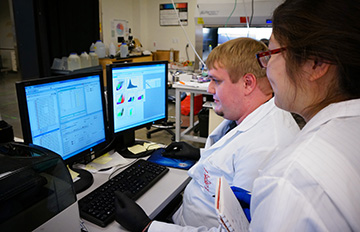
Purdue researchers in Dr. Jill Hutchcroft’s lab
This is the promise of correlative research: transcending traditional disciplinary, geographic, institutional and even personal limitations; science with no boundaries. This inclusive promise springs from a simple, shared purpose. In a word: efficiency.
“I think of correlative science as a way to maximize the efficiency of use of samples that are collected in clinical trials.” says Tommy Sors, PhD, assistant director of the Institute of Inflammation, Immunology and Infectious Disease (PI4D) at Purdue.
“I view samples as a person’s life, I do not see them as a sample,” says Sors. “It is an important perspective to take, because you realize the sacrifice the person had to make for us to have that sample and be able to do experiments on it, look at it, and analyze it. The analysis, implementing the equipment and instrumentation – all of that is very easy and very short; the time it takes for a mass spectrometer to look at a sample is very short. It took years of disease and suffering for that sample to come to us. If we can extract as much information as possible out of that sample that was so preciously donated by that person, and we can maximize the use of that sample, then for the patients who are enrolled in these clinical trials, we are returning some of the favor they show in donating a piece of their body to us.”
The highest regard for patients and their contributions: this perspective drives the purpose of collaborative research and enlivens its promise. It is not limited to those with direct patient interaction. It pulses through all scientific disciplines, and it galvanizes a zeal to fully and painstakingly excavate every nanoparticle of scientific knowledge a sample can provide.
On the leading edge of discovery, correlative research demands the convergence of people and technologies to leave no stone unturned, because every part of a sample has a story to tell. The result is accumulated data available for statistical analysis – oncology’s own “Information Age.” As researchers pinpoint the interrelationships of precisely measured variables, they map out matters of “causation.” Simply stated, while experimental research tells us what happens, correlative research can tell us why.
The practical benefit of this research is quantified by personalized treatment options that are based on knowing who is most likely to benefit and who might be at risk for complications or might not respond to treatment. For patients and their physicians, this knowledge is priceless.
Correlative Research and the Big Ten CRC
The Big Ten Cancer Research Consortium (Big Ten CRC) is transforming cancer research through collaborative, hypothesis-driven, highly translational oncology trials that leverage the scientific and clinical expertise of Big Ten universities. Significantly, all Big Ten CRC studies are required to have a correlative component. Toward that end, the Big Ten CRC has an active Correlative Sciences Clinical Trial Working Group (CTWG) which reviews protocols in development, discusses with the sponsor-investigator possible additions to the correlative plan, facilitates consideration of technologies and platforms, hosts discussions to collaboratively solve technical problems, and promotes discovery of research opportunities at various core facilities across the Big Ten CRC.
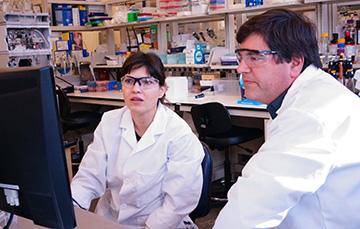
Christina Ferreira, PhD, and Bruce Cooper, PhD
“One of the advantages of the Big Ten CRC CTWG is that we all get to participate at the same time in looking at where we could do better for the samples that are collected,” says Sors, co-chair of the CTWG. “At the same time, we get to understand what the resources are at our partner institutions that could help us ask other questions. For example, the Bindley Bioscience Center has a robust information structure for mass spectrometry-driven metabolic and proteomic analysis. That is great, but what about our partner institutions? What facilities do they have and what expertise do they have that could complement those facilities that are here at Purdue, so we could ask bigger, greater questions?”
Correlative Research and Bench Science
A synergy exists between correlative research and bench science. While technological advancements in the lab allow for greater precision in understanding disease, samples collected through clinical trials are extremely valuable to bench scientists in demonstrating the value of new technologies and processes.
“This is all about the bioanalytical,” says Christina Ferreira, lipidomics research scientist at Purdue’s Metabolite Profiling Facility. “We are a biological lab. If we have a sample, we will give you an analysis. We are at a time where analytical technology and mass spectrometry can do a lot for translation and that is what the Big Ten CRC is offering us. If we can do that molecular investigation inside clinical trials, we think we could see a lot of what makes people respond well or poorly.”
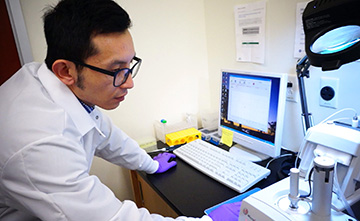
Jia Ma, PhD
Bringing the Best of the Lab to Clinical Research
As a Big Ten CRC member, Purdue University is filling out that picture in full color to bring the best of the lab to clinical research. Timothy L. Ratliff, PhD, is the Robert Wallace Miller director of the Purdue University Center for Cancer Research. “The Purdue Cancer Center is an NCI designated center that was founded in 1978, so we were approaching our 40th anniversary,” says Ratliff. “We are a basic science center – one of only seven in the country. Our focus is on understanding how a cancer cell works, what makes it a cancer cell, and then developing drugs to interfere with that process.”
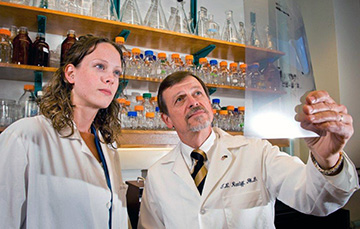
Timothy L. Ratliff, PhD
“Purdue is not directly associated with a hospital or medical school as some campuses are,” says Bruce Cooper, PhD, director of the Metabolite Profiling Facility. “It has been very valuable for some of our chemists who have synthesized new compounds and want to bring that to human clinical trials to collaborate through the Big Ten CRC and find where clinical trials can be conducted.”
This collaboration is possible because of the confidence Big Ten CRC members have in each other. “It is critical that you have people of integrity and high-caliber scientific and clinical skill levels to collaborate with,” says Hutchcroft. “Having access to high-quality samples and people to interact with is key. In any science, you have to completely trust that what someone is bringing you has been properly obtained and properly cared for. It is tremendously dangerous to deal with things that are not done well. It is great to be able to make connections within the Big Ten CRC with people you know are doing outstanding work.”
Purdue’s collegiality makes the institution a natural member of the Big Ten CRC. “Purdue is an absolutely great place to do science; this is a place where people work together,” says Hutchcroft. “At a lot of institutions, there is so much competition and fear between individuals that people do not want to interact with others; they do not want to tell you what they are really doing. Here everyone genuinely wants your research to work. That is one thing that really sets Purdue apart at all levels of the institution, from the students to the faculty and staff. People really pull together here.”
That collegiality and teamwork spring from a spirit of generosity. “It is important for all of us to work together across different institutions because doing cutting-edge science or medicine is tremendously expensive,” says Hutchcroft. “It is to nobody’s benefit to have an expensive piece of equipment just sitting there; it has to be busy to be useful. The more people can bring us samples the happier we are.”
Core Facilities of the Bindley Bioscience Center
The Bindley Bioscience Center (BBC) is Purdue’s multidisciplinary research facility where life sciences and engineering researchers collaborate. The BBC resides at Purdue’s aptly named Discovery Park, which was designed to foster collaboration between different departments and disciplines. There you will find the BBC’s team of Core Facilities, like the Bioscience Imaging Facility.
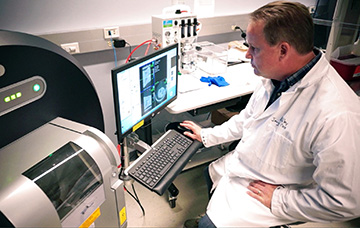
Andy Schaber, PhD
The Metabolite Profiling Facility is also there. “We look at lipids of many, many classes in a very fast way,” says Ferreira. “As far as I know, we are the only facility that offers this type of very fast exploratory study of lipids. We call this accelerated biomarker discovery of lipids.” Ferreira observes the power of correlative research to ensure that protocols coming from the bench to the bedside are personalized. “Every individual is metabolically so different, so if we average everybody it would not be fair to anybody because nobody is average,” says Ferreira. “Through metabolic profiling, we could see panels of molecules which indicate the potential of this therapy being a fit for this person at this stage, at this disease, or at this age.”
Next door is the Purdue Proteomics Facility, led by Uma Aryal, PhD. “One of our priorities is to identify proteins in the cell and quantify them so we can measure how these proteins are regulated in the cell,” says Aryal. “When it comes to disease, the old concept was one gene and one protein involved in the disease. But it is not one protein or one gene; there is a whole set of proteins, they are functioning in the same pathway that might be affected by those diseases. We need to find the multiple biomarkers from the same disease.”
Partnership Success

Uma Aryal, PhD
Such activity builds on Purdue’s strong history of collaboration with other Big Ten institutions. “One of our chemists, Phil Low, had developed a targeting molecule for prostate cancer cells,” says Ratliff. “We partnered with Indiana University Simon Cancer Center and we synthesized the compound here at Purdue. We did all the vialing here at Purdue, validated it was appropriate for patient care, sent it out, and IU ran the Phase 0 Trial. We did an imaging trial first; it really identified prostate cancer so specifically. Now, that compound is in clinical trial for therapeutic outcomes and is also being used for imaging in prostate cancer. So, it is a tremendous success.”
The promise of correlative research — and the Big Ten CRC — shines brightly at Purdue. “The scientific discoveries are really exciting to see after you go from the theory in the lab to real life in the clinic,” says Hutchcroft. “There are people that are alive now because they got these kinds of treatments. These are things that, when I was in graduate school, we just talked and had seminars about; it is really happening in the clinic. That is quite satisfying.”
“I am very hopeful that we will be able to contribute as every researcher dreams about having a positive effect on society,” Ferreira says. “It is the best trophy we can get, to know our work impacted positively even one person – and many people, if possible.”
About the Big Ten Cancer Research Consortium: The Big Ten Cancer Research Consortium was created in 2013 to transform the conduct of cancer research through collaborative, hypothesis-driven, highly translational oncology trials that leverage the scientific and clinical expertise of Big Ten universities. The goal of the Big Ten Cancer Research Consortium is to create a unique team-research culture to drive science rapidly from ideas to new approaches to cancer treatment. Within this innovative environment, today’s research leaders collaborate with and mentor the research leaders of tomorrow with the unified goal of improving the lives of all patients with cancer.
About the Big Ten Conference: The Big Ten Conference is an association of world-class universities whose member institutions share a common mission of research, graduate, professional and undergraduate teaching and public service. Founded in 1896, the Big Ten has sustained a comprehensive set of shared practices and policies that enforce the priority of academics in the lives of students competing in intercollegiate athletics and emphasize the values of integrity, fairness and competitiveness. The broad-based programs of the 14 Big Ten institutions will provide over $200 million in direct financial support to almost 9,500 students for more than 11,000 participation opportunities on 350 teams in 42 different sports. The Big Ten sponsors 28 official conference sports, 14 for men and 14 for women, including the addition of men’s ice hockey and men’s and women’s lacrosse since 2013. For more information, visit www.bigten.org.
















Subscribe to the Big Ten CRC Newsletter X
X Facebook
Facebook YouTube
YouTube